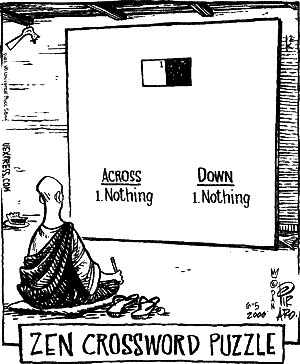Zen-Speak
Some common Zendo terms
Council
A circle practice of speaking and listening from the heart that uses a talking piece. Who ever is holding the talking piece has the floor and no cross talk or interuptions is allowed.
Chiden
In charge of taking care of all the altars. The chiden trims the candles or replaces them when they are used up. They arrange all the flowers for the altar and make sure each altar is ready for the teacher, when they do their morning rounds at each of the altars.
Daisan
Person interview between teacher and student.
Day of Reflection
A form of zazenkai practice where we focus on the precepts as part of our practice.
Dennan
Person who distributes and picks up sutra books during service.
Densho
A large hanging temple bell that is used during services.
Doan
The head musician who rings many of the bells during a service.
Inkin
A small bell on a wooden handle that is rung by the sogei, the doan and the jikido at various times during zazen or during services.
Jikido
The time keeper. Has many functions during sesshin. During regular weekly sitting, the jikido is responsible for opening and setting up the zendo, keeping time and ringing bells to signal the beginning and end of zazen periods, and closing up the zendo upon the completion of zazen.
Jiko
One of the three positions making up the jishario. This person carries the incense (hako) box.
Jisha
One of the three positions making up the jishario. This person is the attendant to the teacher or the officiant. As attendant to the teacher, the jisha may have many functions, from opening and closing daisan lines to serving the teacher tea and water during retreats. As a member of the jishario, the jisha carries a lighted stick of incense and brings it up to the officiant at the beginning of the service. If other sutras are chanted in the service, the jisha will go up to the altar to light the incense stick and give it to the officiant.
Jishario
Consists of three positions (jisha, sogei and jiko) who are part of any procession bringing an officiant into a buddha hall for service or some other occassion such as a teisho.
Jukai
A ceremony in which a student receives the precepts, a rakusu and a dharma name.
Gassho
Hands placed palm to palm.
Han
Hanging wooden block that is struck to signal various practice events.
Haishiki
Officiant's bowing mat placed in front of the main altar in zendo or buddha hall.
Ino
Head chanter, in charge of all service positions in the buddha hall during service. When chanting during a service, people are instructed to chant with their ears, and to listen to the ino's voice which is the lead voice. The ino sets the tempo and pace and pitch for all sutras chanted during service.
Mokugyo
The wooden drum and the person who hits it. It is used primarily during services to keep time.
Monitor
The monitor always sits out and is in charge of keeping order in the zendo. They control when and how people enter the zendo. They make announcements at the end of zazen. If you pass in front of the monitor position, it is customary to gassho and bow.
Sesshin
A traditional Zen retreat that involves intensive zazen meditation. It is conducted in silence.
Shosu
Person who rings the densho bell.
Sogei
Person who rings the inkin bell. They are one of the three people in the jishario.
Tenzo
Head cook, in charge of all food during sesshin and for any other sangha gathering.
Zazen
Zen upright meditation that is done either cross legged, in seiza (on the knees) or in a chair.
Zazenkai
A half-day or full day of Zen practice to strengthen and honor the sangha and to help maintain the buildings and grounds that support everyone's practice.
